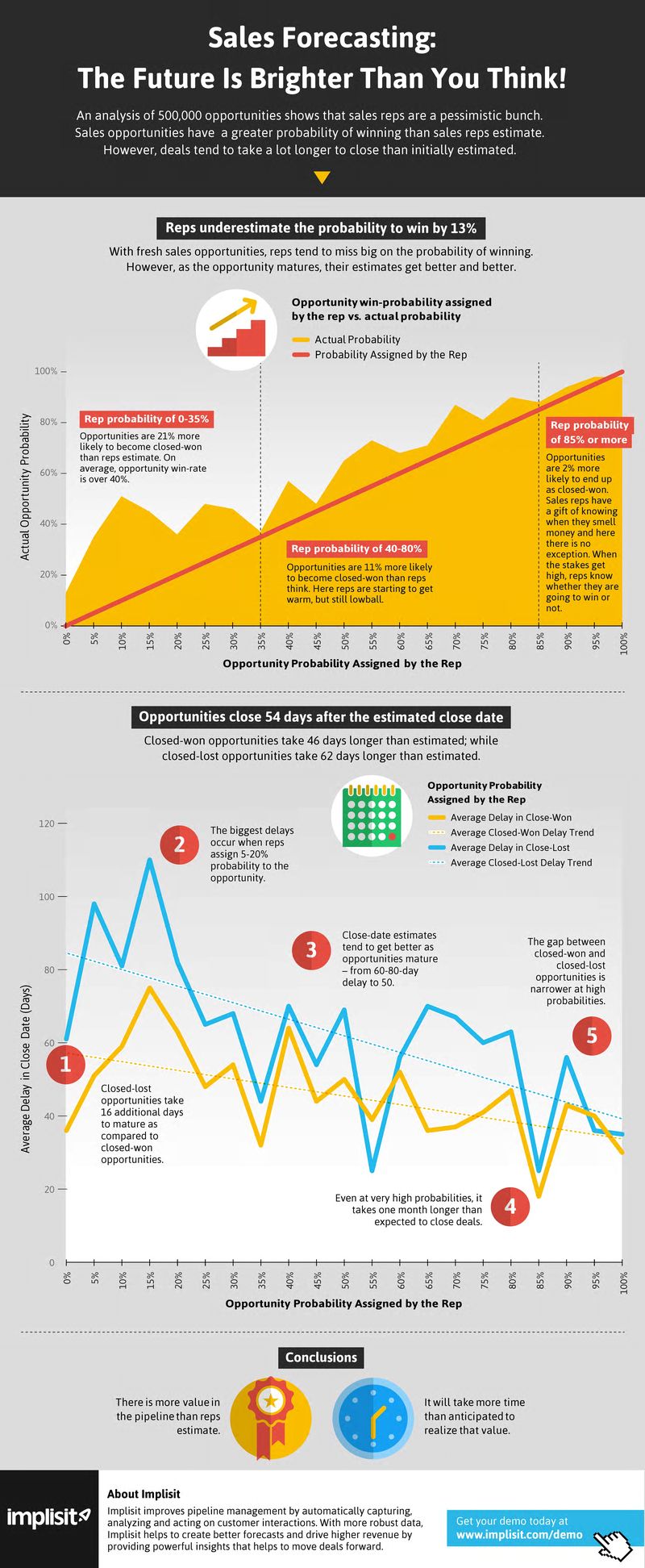
Sales reps often underestimate the chances of winning opportunities and tend to close deals much later than they predicted. On average, opportunities are 13% more likely to close than reps think. However, the actual close date is usually over 2 months later than what the rep estimated.
For this research, Implisit examined anonymous data from 500,000 opportunities across hundreds of companies. For each opportunity, we assessed the probability given by the rep throughout the opportunity’s duration and the actual probability. The actual probability is calculated by dividing the number of opportunities that were closed-won by the total number of opportunities.
Reps underestimate the probability to win
When an opportunity is first created in Salesforce, it is assigned a lower probability. Our data shows that this does not reflect the real probability to win. In fact, when reps assign a probability of 0-35% to an opportunity, the actual win rate is over 40%.
This gets slightly better as the opportunity progresses through the funnel. When reps assign probabilities of 40-80%, opportunities are 11% more likely to end up as closed-won than reps estimate.
Reps tend to be a lot more accurate when assessing the likelihood of opportunities with high probability to win. Our data shows that when reps assign likelihood of 85-100% to an opportunity, there is only a 2% margin for error. When the probability is high and reps are in the final stages of closing the deal, their estimates become significantly more accurate.
Sales reps are the ones most involved with prospects and have the most accurate information about what is going on with a deal. How come they have a hard time predicting the likelihood of an opportunity? There may be two main reasons for that:
Firstly, reps may want to be conservative in estimating the probability to close in order not to put pressure on the organization and on themselves.
Secondly, it is hard to estimate the probability based on the initial call and limited prospecting. It is easier to estimate when it’s down to the final stages of negotiation.
Opportunities are delayed by 2 months
According to Implisit’s data, close date is hard to predict. Data shows that on average, opportunities close only 54 days after the estimated close date. Furthermore, closed-won opportunities take 46 days longer than estimated. Closed-lost opportunities take 62 days longer than initially estimated. Thus, closed-lost opportunities take 16 days longer than closed-won opportunities to close. Therefore, deals expected in this quarter may only come to fruition next quarter.
More specifically, we found that the biggest delays in close date are when reps assign 5-20% probability to the opportunities. At the initial stage, it is not only hard to guess the probability but also the sale cycle.
When opportunities mature to higher probabilities, close date estimates become better. Delay in close date drops from 60-80 days to only 50 days. This drops further to 40 days at very high probabilities. In addition, the gap between closed-won and closed-lost opportunities in terms of the delay in close date is narrow at high probabilities.
Overall, it seems that there is more value in your pipeline than is initially estimated. In addition, it may take more time than estimated to realize this value. Still, is there a way that we can forecast sales better than just using intuition?
Predictive forecasting
Enter predictive sales forecasting. Predictive sales forecasting uses data hidden in our customer emails to predict the likelihood to close. It evaluates words and phrases used in customer emails, compares them to words and phrases in millions of other emails and, using predictive models, assesses the likelihood to close and the most probable close date. At Implisit, we believe that our intuition can take us only so far, but predictive forecasting will deliver more robust and accurate predictions.
Want to make 2015 the year you close more deals than ever? Download the free Salesforce e-book with 130 sales tips:

